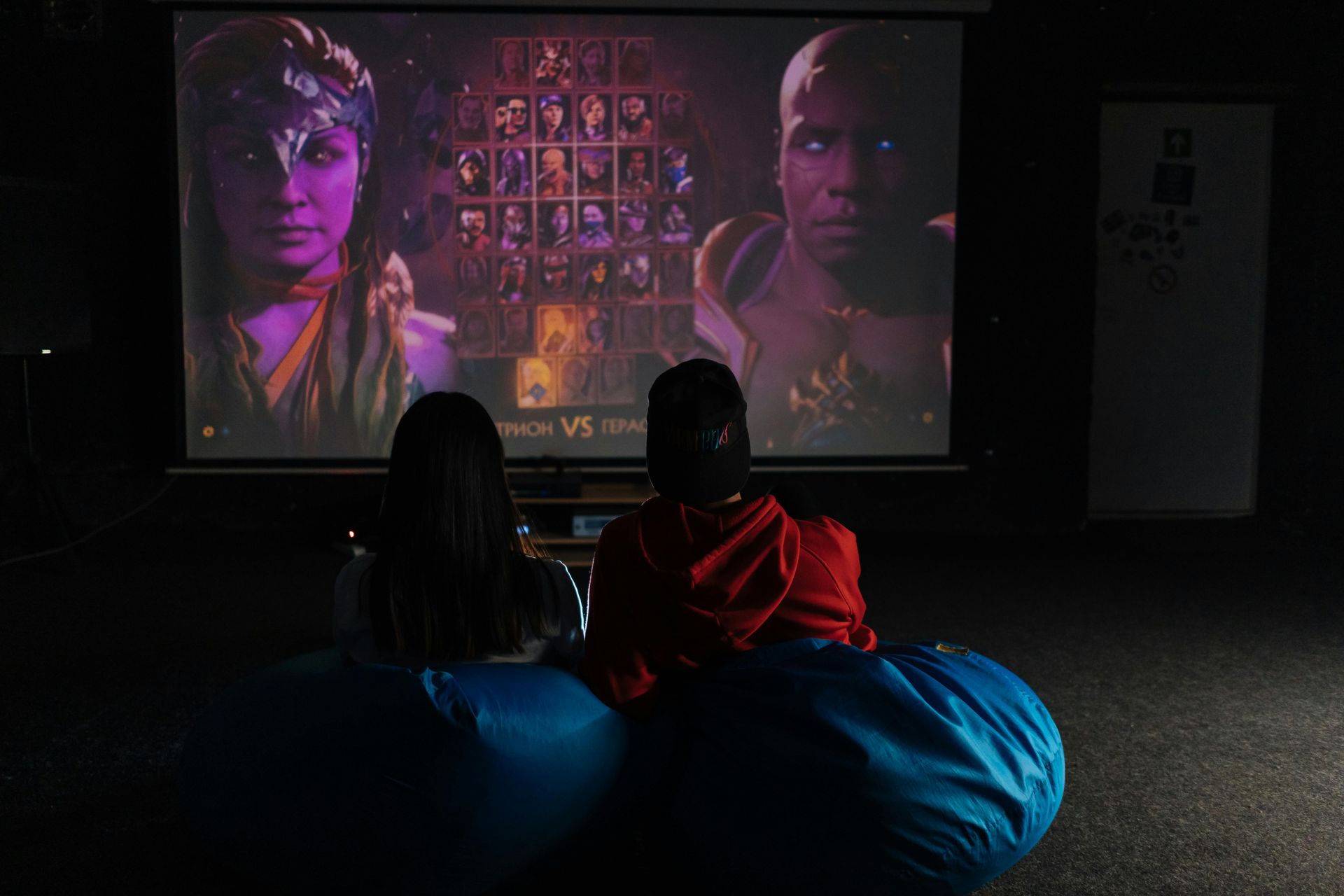Crafting Your Dream Home Theater: A Deep Dive into Display Technologies
Crafting Your Dream Home Theater: A Deep Dive into Display Technologies
In today's competitive real estate market, homes that offer unique, high-end amenities stand out. A professionally designed home theater is more than a luxury; it's a lifestyle feature that significantly enhances a home's appeal and value. Whether you’re looking to create a personal sanctuary or a social hub for friends and family, understanding your display options is the first step toward building a dream entertainment space.
From state-of-the-art flat-screens to full-scale cinematic projectors, let’s explore the pros and cons of each choice, helping you envision the perfect media room for your property.
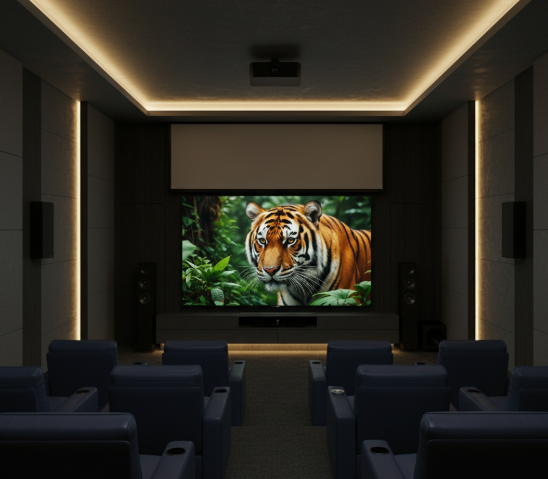
1. The Modern Mainstay: The Large Flat Screen TV
A large flat-screen television is the centerpiece of countless modern living spaces. With sizes up to 98 inches, today's TVs offer a blend of stunning visuals and user-friendly technology, making them an excellent choice for any home.
- Pros:
- Excellent Picture Quality: Modern OLED and QLED TVs deliver stunning contrast, vibrant colors, and deep blacks.
- Ease of Installation: Generally, these are plug-and-play. Mount it on the wall or place it on a stand, and you're good to go.
- Integrated Smart Features: Most come with built-in streaming apps and smart home integration.
- Good for Ambient Light: They perform well even in rooms with some ambient light, unlike projectors.
- Cost-Effective (Relatively): While larger sizes can be pricey, they often offer the best performance-to-cost ratio for smaller home theater budgets.
- Cons:
- Size Limitations: Even the largest flat-screens can't match the sheer scale of a projected image or an LED wall.
- Reflections: Glossy screens can be prone to reflections from windows or bright lights.
- Permanent Fixture: Once mounted, moving a very large TV can be a two-person job.
Room Design Considerations:
A large flat-screen works well in a dedicated home theater or a multi-purpose living room. For optimal viewing, consider the distance from your seating to the screen. Companies like Crutchfield offer excellent guides on screen size and viewing distance. A well-designed media console or custom built-ins can integrate the TV seamlessly into your decor.
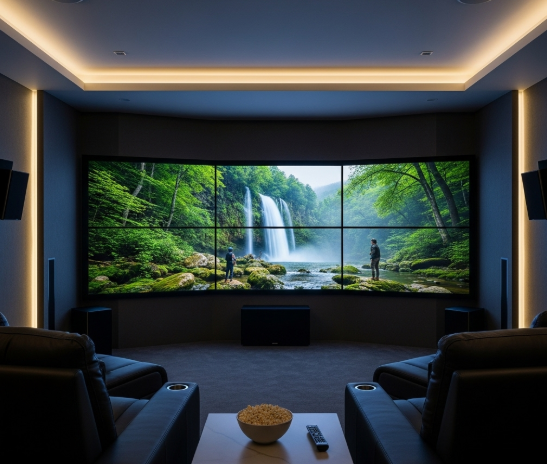
2. The Dynamic Hub: Multi-Screen Entertainment Walls
For the ultimate sports fan or dedicated gamer, a video wall comprised of multiple flat-screens is a game-changer. This setup allows for multiple events or gaming sessions to be displayed simultaneously, creating a truly unique and interactive entertainment zone.
- Pros:
- Ultimate Multi-Tasking: Ideal for displaying multiple sources simultaneously without compromise.
- Unique Aesthetic: Can create a striking visual centerpiece, especially in a modern design.
- Scalability: You can choose the size of each individual screen to fit your space.
- Cons:
- Complex Installation: Requires careful planning for mounting and cable management.
- Specialized Controller Needed: A dedicated video wall controller is essential to manage and display multiple inputs. This adds significant cost and complexity.
- Bezels: The bezels between the screens will always be visible, creating a grid effect.
- Higher Cost: Four TVs plus the controller will generally be more expensive than a single large TV or even some projectors.
Room Design Considerations:
This setup demands a spacious wall and careful consideration of viewing angles. A custom-designed feature wall or recess can help integrate the screens elegantly. Lighting control is also crucial to avoid glare on multiple surfaces. This setup often finds its home in high-tech entertainment rooms or sports lounges.
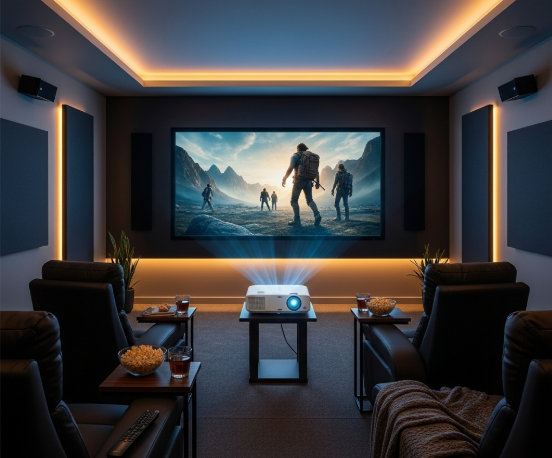
3. The Authentic Cinema: The Home Projector
For an authentic movie theater experience, a high-quality projector is the only choice. Transforming a space into a private cinema, a projector can cast an image far larger than any TV, from 100 to over 150 inches.
- Pros:
- Unrivaled Screen Size: Projectors can easily create images of 100 inches, 120 inches, or even larger, providing a truly cinematic scale.
- Immersive Experience: The large image fills your field of view, pulling you into the content.
- Hidden Display (Often): When not in use, the screen can retract, leaving a clean, unobtrusive space.
- Variety of Technologies: From DLP to LCD to laser projectors, options exist for various budgets and performance needs.
- Cons:
- Ambient Light Sensitive: Projectors perform best in a very dark room. Any ambient light will wash out the image.
- Installation Complexity: Requires careful placement, mounting, and calibration for optimal image geometry.
- Screen Required: A dedicated projector screen is essential for the best picture quality, adding to the cost and installation.
- Maintenance: Lamps have a finite lifespan and need replacement (though laser projectors mitigate this).
- Resolution Considerations: Achieving true 4K resolution can be more expensive than with flat-screen TVs.
Room Design Considerations:
A projector absolutely thrives in a dedicated home theater room with excellent light control. Darker wall colors and blackout curtains are highly recommended. Consider the "throw distance" (how far the projector needs to be from the screen) when planning your room layout. Custom ceiling mounts for the projector and a recessed screen can ensure a clean aesthetic when not in use. Companies like Audio Advice are experts in projector-based home theater designs.
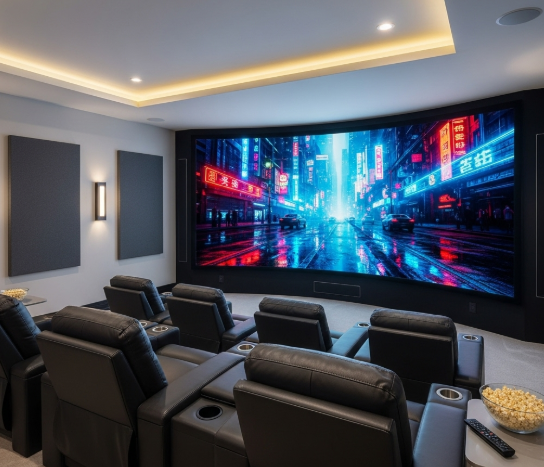
4. The Next Level Luxury: Cutting-Edge LED Walls
Representing the pinnacle of home entertainment, an LED wall is a modular display that creates a single, stunningly bright, and seamless image of virtually any size. This is the same technology used in major stadiums and concert halls, brought into the private residence.
- Pros:
- Unlimited Size: LED walls are modular, meaning they can be built to virtually any size, limited only by your room.
- Seamless Image: Unlike multi-screen setups, there are no bezels, creating a perfectly continuous image.
- Incredible Brightness & Contrast: LED walls offer astounding brightness, making them suitable even in brightly lit rooms, and fantastic contrast.
- Longevity: LEDs have a very long lifespan.
- Future-Proof: Represents the cutting edge of display technology.
- Cons:
- Astronomical Cost: This is by far the most expensive option, often costing tens or even hundreds of thousands of dollars.
- Complex Installation: Requires specialized installers and significant infrastructure.
- Power Consumption: Larger LED walls will consume more power than other options.
- Heat Generation: Can generate a noticeable amount of heat in the room.
- Pixel Pitch: While improving, very close viewing distances might reveal individual pixels on some models.
Room Design Considerations:
An LED wall requires a dedicated, robust wall structure to support its weight. Ventilation for heat dissipation is also crucial. Due to their scale and cost, these are typically reserved for very large, high-end dedicated home theaters or luxury entertainment spaces. Companies specializing in custom integration like CEDIA members are the go-to experts for designing and installing LED walls in residential settings.
Conclusion
Choosing the right display for your home theater is a pivotal decision that will shape your entire entertainment experience. Each option, from the versatile flat-screen to the awe-inspiring LED wall, offers distinct advantages and considerations. Carefully assess your budget, room size, desired level of immersion, and whether you're looking for a dedicated dark-room experience or a versatile family entertainment hub. By understanding the pros and cons of each and consulting with home theater design experts, you can create a truly spectacular and personalized home cinema that brings your favorite movies, sports, and games to life.
Disclaimer:
This blog post is for informational and entertainment purposes only. The information provided is based on general knowledge of home theater design and is not a substitute for professional advice. The author, John Taylor, is a licensed real estate professional and not a professional contractor, installer, electrician, or audio/visual specialist.
Readers should always consult with qualified and licensed professionals (e.g., home theater installers, electricians, and general contractors) to ensure that any home improvement projects are completed safely, correctly, and in compliance with all local building codes and regulations. The author and the associated website are not liable for any damages or issues that may arise from the use of the information contained in this blog post.
Share this Post


